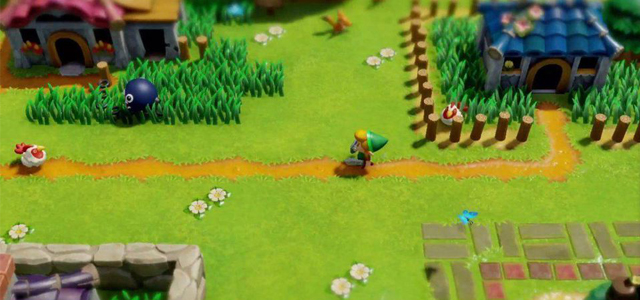Review: The Legend of Zelda: Link’s Awakening
The Legend of Zelda: Link’s Awakening has been an oddity in the Zelda canon since it debuted on the Game Boy in 1993. It took Link away from Princess Zelda and his home in Hyrule, stranding him on Koholint Island, a small but intricate location full of odd characters and secrets. As you ventured through the game’s dungeons, the true nature of the island became clear, and Link came to realise that getting back home would carry a terrible cost.
The game – which has now been remade and released for the Nintendo Switch – was heavily inspired by David Lynch’s cult 90s TV series Twin Peaks, and remains one of the weirder entries in the series. Link’s Awakening is largely about dreams, and it’s meant to feel like one. It’s an off-kilter, weird entry in the series, one that’s unsettling without ever quite tipping over into being disturbing. Some have argued that it’s one of the absolute best Zelda games; I wouldn’t go that far, but it’s certainly a strong entry.
On the Game Boy, Link’s Awakening was a marvel of ambition, a full-sized Zelda with few compromises on a system that was best known for Tetris. This new iteration is based on the 1998 Game Boy Color version of the game, which added a few neat extras and a whole extra dungeon.
On Switch, of course, it’s not as impressive an achievement especially since series highpoint The Legend of Zelda: Breath of the Wild launched with the system. But it’s a testament to the Game Boy classic’s design sensibilities that this new version is also fantastic. No matter how many other Zelda games you’ve played in your life, nothing will take away from how clever, fun and weird Link’s Awakening is. The game has only been lightly modernised: it’s meant to be the definitive version of a classic rather than a whole new take on it. It’s got a gorgeous new visual style and a re-recorded soundtrack, but underneath everything it’s the same great game that folks loved in 1993.
The format will be familiar to you if you’ve played Zelda before. You travel around the map, conquering dungeons and unlocking abilities, growing in strength and gaining new items until eventually you’re prepared for the final challenge. At first, it can be intimidating – your health is low, and the world is full of enemies and objects you can’t interact with yet (stones you can’t pick up, holes you can’t jump over, and so on). But after a few hours, as your strength and confidence grow, the world starts to unfurl for you. Part of the joy in Zelda has always been in the way you feel more at ease, and more powerful, as the game goes on, and by the midpoint of Link’s Awakening I felt confident and strong.
The world of Link’s Awakening is small, but deep, with lots of secrets to discover. It encourages you to pull at every thread and check under ever stone (literally: pick up and throw away every stone you find). Nintendo fans will notice that the game is also packed full of explicit references to other Nintendo series, especially Mario, whose enemies pop up frequently. This is all part of the game’s unique ‘dream’ vibe, and it helps Link’s Awakening to stand out against the 12 other major Zelda titles that have released since 1993.
This is a straightforward remake, in some ways – most locations are unchanged, the script is exactly the same, and if you remember the way through each dungeon you won’t find any unexpected surprises. But the game is a lot easier to play now thanks to a few tweaks. The Game Boy only had two main buttons, but the Switch version maps some of your most frequently used items to its spare buttons so that you don’t need to continually swap out your sword and shield for other objects. The dungeons won’t push you as hard as the 3D Zelda titles do – the puzzles usually require a lot of observation and exploration rather than logic, and most of them are short by modern standards. But they’re a lot of fun and cleverly designed throughout.
The most major addition is a section that lets you create and conquer your own dungeons. It’s a very limited mode, though – you unlock rooms from the dungeons you’ve beaten, but how you place them depends on where you can enter and exit each room from, and there’s no way to work in devious puzzles or unique challenges. It means that the dungeons you create will never compare to the ones Nintendo crafted themselves.
But the fact that the one (completely optional) major addition made to this version of Link’s Awakening doesn’t work just speaks to the notion that the game was fine the way it was. The original game was an absolute triumph of overcoming hardware limitations, but this new version, stripped from that context, is still extremely fun and exciting. It’s a dream you’re disappointed to eventually have to wake up from.
The Legend of Zelda: Link’s Awakening is out now on Nintendo Switch.
James O’Connor is a critic and journalist.





